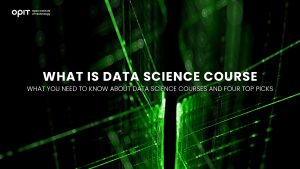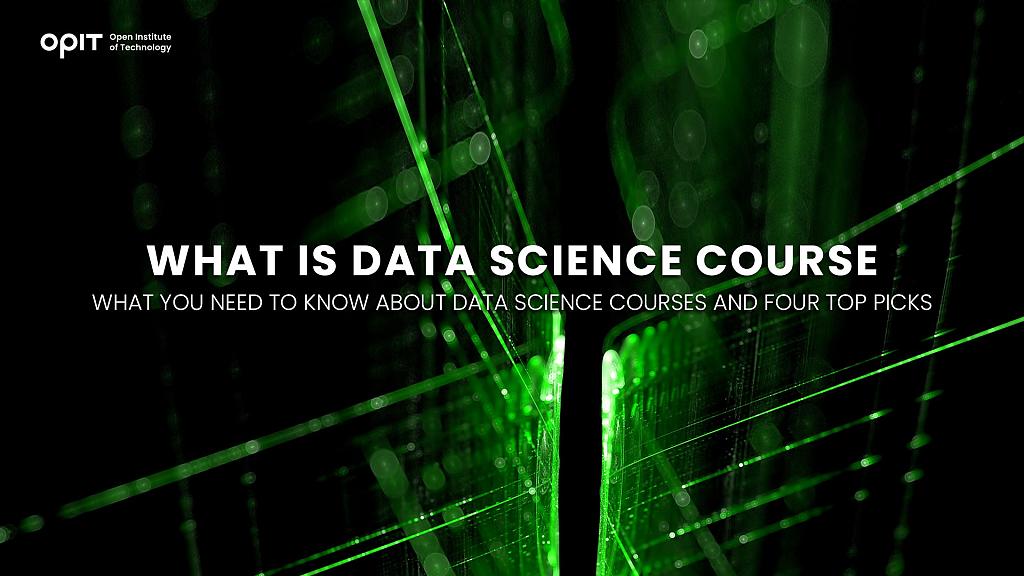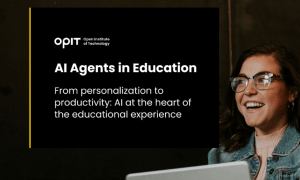

Combine mathematics with analytics, mix in programming skills, and add a dash of artificial intelligence, and you have the recipe for creating a data scientist. These professionals use complex technical skills to parse, analyze, and draw insights from complex datasets, enabling more accurate decision-making in the process.
As companies gather more data than ever before (both about their customers and themselves), these skills are in increasingly high demand. That’s demonstrated by data from the U.S. Bureau of Labor Statistics, which says that the number of data science jobs in the U.S. alone looks set to increase by 36% between 2021 and 2031.
That higher-than-average growth rate creates an opportunity for students, though grasping that opportunity requires a dedication to learning. This article explores the question of what is data science course material and highlights a selection of courses that set you on a data-propelled career path.
What to Expect From a Data Science Course
Answering the question of “what is data science course?” starts with examining the components of the typical course. Bear in mind that these components vary in nature and complexity depending on the specific course you take, though all are usually present.
Overview of Course Content
The content of a data science course is usually split into four core categories:
- Statistics and Probability – Math underpins everything a data scientist does, as they use numbers to spot patterns and determine the likelihood of various potential outcomes. Most data science courses delve into statistics and probability for this reason, with more advanced courses often requiring a degree in a field related to these areas.
- Programming – Whether it’s Python (the most popular data science programming language), R, or SQL, your course will teach you how to write in a language that machines understand.
- Data Visualization and Analysis – Anybody can collect reams of data. It’s the ability to visualize that data (and draw insights from it) that sets data scientists apart from other professionals. A good course equips you with the ability to use visualization tools to shine a spotlight on what a dataset actually tells you.
- Machine Learning and AI – The rise of machine learning transformed data science. Using algorithms created by data scientists, machines can analyze datasets presented to them and learn from the patterns to predict probabilities for different outcomes and even predict market trends. Your course will teach you how to create the algorithms that serve as a machine learning model’s “brain.”
Hands-On Projects and Real-World Applications
If you had the desire, you could read pages and pages on how to tune a car’s engine. But without practical and real-world wrench-in-hand experience working on an engine, you’ll never figure out how what you learn from books applies in the field.
The same line of thinking applies to data science, which is often so technically complex that it’s difficult to see how what you learn applies in the real world. A good data science course incorporates a real-world component through projects and exposure to faculty members who have direct experience in using the skills they teach.
Peer Collaboration and Networking
What is data science course for if not to learn how to become a data scientist? While learning the technical side is crucial, of course, a good course also puts you in contact with like-minded individuals who have the same (or similar) goals as you.
That contact helps you to build the collaborative skills you’ll need when you enter the workforce. But perhaps more importantly, it aids you in creating a network of peers who could lead you to job opportunities or work with you on entrepreneurial ventures.
Top Data Science Courses Available
With the components of a data science course established, you have a vital question to answer – what data science course should you take? The following are four suggestions (two online courses and two university courses) that give you a solid grounding in the subject.
Online Courses
Taking a data science course online gives you flexibility, though you may miss out on some of the collaborative and networking aspects that university-led courses provide.
Course 1 – What Is Data Science? (IBM via Coursera)
Coming with the stamp of approval from IBM, a leading name in the computer science field, this nine-hour course is suitable for beginners who want a self-paced learning approach. It’s part of a multi-part program (the IBM Data Science Professional Certificate) that’s designed to give you an industry-recognized qualification that could fast-track your entry into the field.
As for the course itself, it’s split into three parts, each containing multiple instructor-led videos and quizzes to test what you’ve learned. By the end, you’ll understand what data scientists do, build a basic understanding of various data science-related topics, and see how the profession relates to the modern business world. Granted, the course offers a surface-level understanding of the subject, with more complex topics examined in other classes. But it’s a superb tool for developing the foundation on which you can build with other courses.
Course 2 – Introduction to Data Science With Python (Harvard via edX)
Where IBM’s course equips you with general knowledge, Harvard’s online offering digs into the practical side of data science. Specifically, it focuses on using Python (and its many libraries) to solve data science problems drawn from real-world examples.
The course takes eight weeks, with study time between three and four hours per week. Ultimately, this class helps you build on your established programming skills and shows you how to apply them in a data science context.
As you may have guessed, that mention of building on existing skills means you’ll need a solid understanding of Python to participate in this free course. But assuming you have that, Harvard’s class is ideal for showing you just how flexible the language can be, especially when developing machine learning algorithms. Furthermore, simply having the word “Harvard” on your online certification adds credibility to your CV when you start applying for jobs.
University Programs
University programs demand a larger time (and monetary) commitment than purely online programs, though the upside is that you get a more prestigious qualification at the end. These two courses are ideal, with one even being a hybrid of online and university-level courses.
Course 1 – Master in Applied Data Science & AI (OPIT)
Let’s get the obvious out of the way first – you’ll need a BSc degree, or an equivalent, in a computer science or mathematical subject to take OPIT’s data science Master’s degree course.
Assuming you meet that prerequisite, this course comes in 18 and 12-month varieties, with the latter being a fast-tracked version that delivers the same content while asking you to dedicate more time to studying. It costs €6,500 to take, though early bird discounts are available, and an EU-accredited university delivers it.
The course eschews traditional exams by taking a progressive assessment approach to determine how well you’re absorbing the materials. It’s also focused on the practical side of things, with the application of data science in business problem-solving and communication being core modules.
Course 2 – MSc in Social Data Science (University of Oxford)
As the world’s leading university for seven consecutive years, according to Times Higher Education (THE) World University Rankings, the University of Oxford has outstanding credentials. And its MSc in Social Data Science is an interesting course to take because it specializes in a specific subject area – human behavior.
The degree stands on the precipice of an emerging field as it focuses on using data science to analyze, critique, and reevaluate existing social processes. It combines general machine learning models with more specialized data science tools, such as natural language processing and computer vision, to equip students with a high degree of technical knowledge.
That knowledge doesn’t come cheap, either in time or monetary commitment. The University of Oxford expects students to devote 40 hours per week to study, with overseas students having to pay £30,910 (approx. €35,795) to participate. While these investments are naturally intimidating, the university’s prestige makes the time and money you spend worthwhile when you start speaking to employers.
Factors to Consider When Choosing a Data Science Course
The four courses presented here each offer something different in terms of delivery and the expertise required of the student to participate. When choosing between them (and any other courses you find), you should consider the following questions:
- Does the course content and curriculum align with your career goals?
- Can you make time for the course within your schedule, and how much flexibility does it offer?
- Do the instructors provide the expertise you need and teach in a style that suits your preferred way of learning?
- Will you get an adequate return on your investment, both in terms of the prestige of the certification you receive and the knowledge you gain?
- Have past (or current) students recommended the course as a good option for prospective data scientists?
The Benefits of Completing a Data Science Course
Given the technical nature of the subject, you may be asking yourself what is data science course content going to deliver in terms of benefits to your life. The answers are as follows:
- Your skills improve your job prospects by putting you in pole position to enter a market that’s set for substantial growth over the next 10 years.
- The problem-solving and analytical tools you gain are useful in the data science field and other career paths.
- Any course you select puts you in contact with industry professionals who offer networking opportunities that could lead to a new job.
- You get to learn about (and experiment with) cutting-edge tools and technologies that will become the standard for modern business, and more, in the coming years.
What Is Data Science Course – It’s Your Route Into a Great Career
Let’s conclude by reiterating something mentioned at the start of the article – the data science sector will grow by 36% over the next decade or so.
That growth alone demonstrates the importance of data science, as well as why choosing the right course is so critical to your future success. With the right course, you make yourself a desirable candidate to organizations that are quickly accepting that they need data scientists to help them make decisions for the future.
Related posts

Source:
- Times of Malta, published on September 18th, 2025
4 min read
The gathering brought together academics and technology leaders from prominent European Institutions, such as Instituto de Empresa (IE University), OPIT itself and the Royal College of Arts, to explore how artificial intelligence is reshaping the university experience.
The OPIT AI Copilot has been trained on the institute’s complete academic archive, a collection created over the past three years that includes 131 courses, more than 3,500 hours of recorded lectures, 7,500 study resources, 320 certified assessments, and thousands of exercises and original learning documents.
Unlike generic AI tools, the Copilot is deeply integrated with OPIT’s learning management system, allowing it to track each student’s progress and provide tailored support.
This integration means the assistant can reference relevant sources within the learning environment, adapt to the student’s stage of study, and ensure that unreleased course content remains inaccessible.
A mobile app is also scheduled for release this autumn, that will allow students to download exercise and access other tools.
During examinations, the Copilot automatically switches to what the institute calls an “anti-cheating mode”, restricting itself to general research support rather than providing direct answers.
For OPIT’s international community of 500 students from nearly 100 countries, many of whom balance studies with full-time work, the ability to access personalised assistance at any time of day is a key advantage.
“Eighty-five per cent of students are already using large language models in some way to study,” said OPIT founder and director Riccardo Ocleppo. “We wanted to go further by creating a solution tailored to our own community, reflecting the real experiences of remote learners and working professionals.”
Tool aims to cut correction time by 30%
The Copilot will also reduce administrative burdens for faculty. It can help grade assignments, generate new educational materials, and create rubrics that allow teachers to cut correction time by as much as 30 per cent.
According to OPIT, this will free up staff to dedicate more time to teaching and direct student engagement.
At the Milan event, Rector Francesco Profumo underlined the broader implications of AI in higher education. “We are in the midst of a deep transformation, where AI is no longer just a tool: it is an environment that radically changes how we learn, teach, and create,” he said.
“But it is not a shortcut. It is a cultural, ethical, and pedagogical challenge, and to meet it we must have the courage to rethink traditional models and build bridges between human and artificial intelligence.”
OPIT was joined on stage by representatives from other leading institutions, including Danielle Barrios O’Neill of the Royal College of Art, who spoke about the role of AI in art and creativity, and Francisco Machin of IE University, who discussed applications in business and management education.
OPIT student Asya Mantovani, also employed at a leading technology and consulting firm in Italy, gave a first-hand account of balancing professional life with online study.
The assistant has been in development for the past eight months, involving a team of OPIT professors, researchers, and engineers.
Ocleppo stressed that OPIT intends to make its AI innovations available beyond its own institution. “We want to put technology at the service of higher education,” he said.
“Our goal is to develop solutions not only for our own students, but also to share with global institutions eager to innovate the learning experience in a future that is approaching very quickly.”

From personalization to productivity: AI at the heart of the educational experience.
Click this link to read and download the e-book.
At its core, teaching is a simple endeavour. The experienced and learned pass on their knowledge and wisdom to new generations. Nothing has changed in that regard. What has changed is how new technologies emerge to facilitate that passing on of knowledge. The printing press, computers, the internet – all have transformed how educators teach and how students learn.
Artificial intelligence (AI) is the next game-changer in the educational space.
Specifically, AI agents have emerged as tools that utilize all of AI’s core strengths, such as data gathering and analysis, pattern identification, and information condensing. Those strengths have been refined, first into simple chatbots capable of providing answers, and now into agents capable of adapting how they learn and adjusting to the environment in which they’re placed. This adaptability, in particular, makes AI agents vital in the educational realm.
The reasons why are simple. AI agents can collect, analyse, and condense massive amounts of educational material across multiple subject areas. More importantly, they can deliver that information to students while observing how the students engage with the material presented. Those observations open the door for tweaks. An AI agent learns alongside their student. Only, the agent’s learning focuses on how it can adapt its delivery to account for a student’s strengths, weaknesses, interests, and existing knowledge.
Think of an AI agent like having a tutor – one who eschews set lesson plans in favour of an adaptive approach designed and tweaked constantly for each specific student.
In this eBook, the Open Institute of Technology (OPIT) will take you on a journey through the world of AI agents as they pertain to education. You will learn what these agents are, how they work, and what they’re capable of achieving in the educational sector. We also explore best practices and key approaches, focusing on how educators can use AI agents to the benefit of their students. Finally, we will discuss other AI tools that both complement and enhance an AI agent’s capabilities, ensuring you deliver the best possible educational experience to your students.
Have questions?
Visit our FAQ page or get in touch with us!
Write us at +39 335 576 0263
Get in touch at hello@opit.com
Talk to one of our Study Advisors
We are international
We can speak in:
